Dangerous Secrets of the DOT Standard

D. O. T. … it’s not as safe as you think. So I had to ask myself, what violence … can it actually survive? Because the only way to see the strength of a helmet for yourself, is to kill it.

But before we get into that, a little background…
What is DOT?
In 1974 the federal government was under pressure to define new safety standards. With time running out, they make a smudgy copy of an ANSI criterion from three years prior. They call it FMVSS218. Common alias… DOT.
But here’s the thing. See ANSI Z90.1 wasn’t exactly based on motorcycle head injuries. It used existing data on automobile accidents - that is, unhelmeted victims.
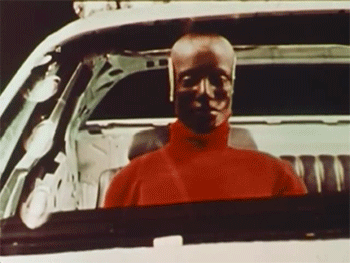
DOT allows 400Gs at impact. That’s literally a pickup truck sitting on your head, with a dwell time of 4ms above 150G, and 2ms above 200. On the fleshy side of a motorcycle helmet, it’s far too much.
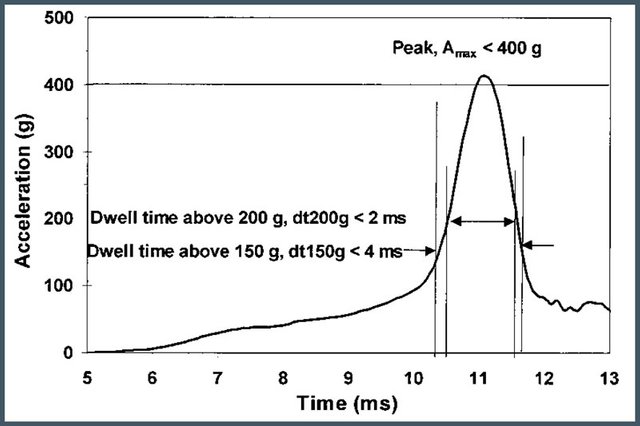
Modern science tips the scale toward skull fracture at 290G. That’s why all the other standards cap the limit around that lower level. Snell, ECE… even the ANSI criterion that DOT ripped off switched to a 300G limit in 1979.
We all know what’s best for riders. One of us just doesn’t seem to care.

Wrong from the Start
DOT knew their standard was off-base from the beginning. The document they copied in '74 was already outdated. At first the fellas promised to update within 18 months, but '76 came and went. So did '77, '78 and '79. In 1980 DOT returned to their paperwork, but only to mandate that all helmets be tested with a medium headform.
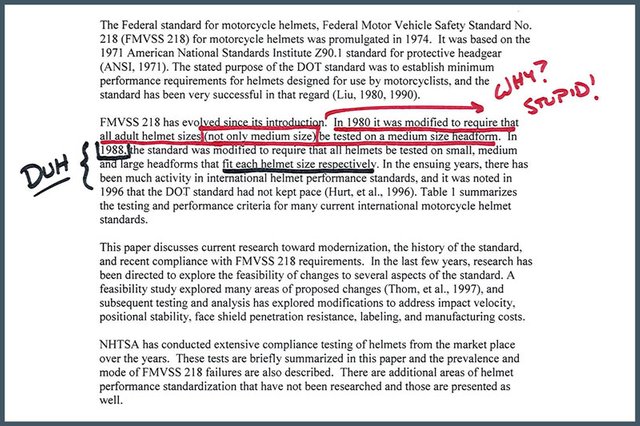
We don’t know why, or by whom, that amendment was passed. But we do know they rectified the mistake in 1988. Some bright spark realized what a human head looked like and suggested they switch to full jawline forms in various sizes. The jaw thing didn’t happen, but at least they started testing small helmets with small blockheads, and large with large.
DOT basked in that ninnyhammer success for a decade or so. Not that they could be bothered to make another update at the end of it. Instead they commissioned the 1997 study to assess the feasibility of updating. Typical government.
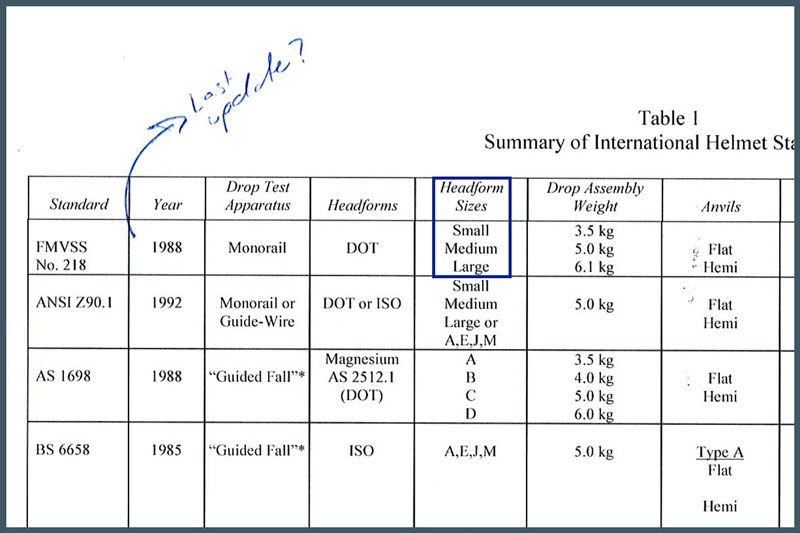
I don’t know if the feds were surprised by the report, but they should've been. DOT is eons out of date, 400Gs are not an acceptable level of shock, the national budget can afford a BB gun, so no reason not to test face shields. Likewise chin bar strength and roll off...
Dollars to donuts you’ve never even heard of this explosive report. See explosive things that don’t explode get buried. Meaning DOT’s weak spots have sat unresolved for 21 years now. Unprotected.

If this were Snell, the faceshield would have been tested for puncture strength.
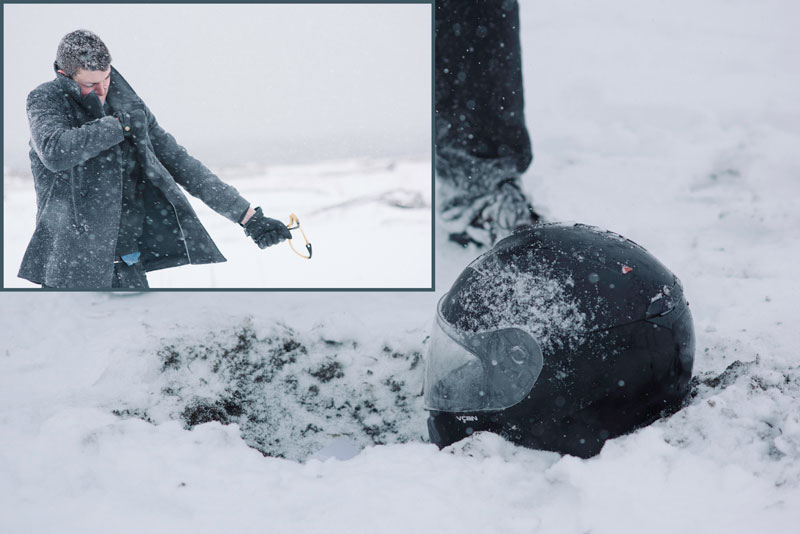
DOT buckets aren’t tested for roll off so …

You get the picture.
Missing Information
Bad helmets are part of this big bad world and that’s okay, unfortunately the lack of communication doesn't stop it from spinning. Labs have a full report on every helmet. Actual numbers for how much shock it transmits. Why don’t we get those numbers?

When I tried to pull test results for my own buckets… all of them were “missing.” Maybe never released to the public. Maybe lost in the void between public and publisher. Somewhere on the other side of an email address that nobody answers.
Why? Why do we get nauseating detail on whether this cow had a fulfilling life, and which 1960s bucket this vintage chin bar tributes, but when it comes to the safety of our safety equipment all we get is a sticker? Someone’s gonna get hurt over it…
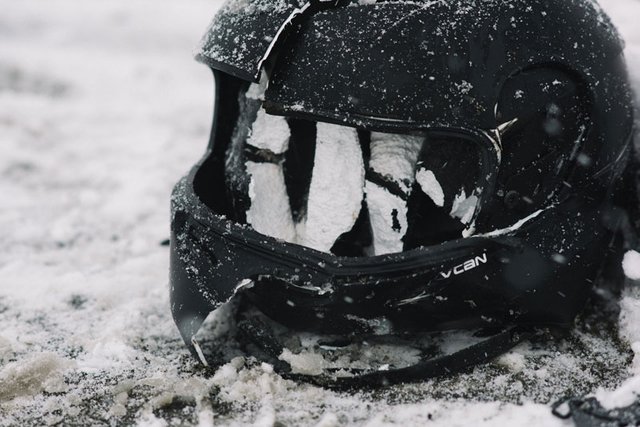
If we had access to test results, we’d know this chin bar was too thin. If we knew the 65mm deflection, we could have gauged its safety versus the other options. And all this if DOT bothered to test chin bars at all.
The raw truth is that DOT doesn’t test anything. They set the minimal standards – a few flat anvil drops, some hemispherical, a couple tugs and a couple punctures – but it’s up to manufacturers to actually perform the tests and self-certify.
Self Certification
Yes, that's right, self. certification.
- First, manufacturers cheat the test. With freedom to choose their own impact locations, they can and do make helmets that are strong in specific test areas. And weaker everywhere else.
Snell gives technicians leeway to search out the weakest spots, and test them in particular. Because when your weakest links are strong enough, it doesn't matter which way you fall.
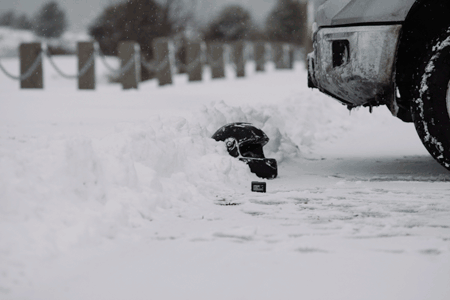
- The second problem with self-certification is that manufacturers lie.
In 2006 the Office of Vehicle Safety bought 40-odd DOT helmets... hoping to verify their qualification. Of these, 13 were questionable for safety, 5 for labelling, and 7 models had to be recalled entirely. From this small sampling alone, it appears 42,120 helmets left the factory with DOT stickers, but were not in fact up to standard.
And that’s not including all the models that go unverified! The 2006 sampling is too small to incriminate, but going back you can find bulk compliance tests with larger but similar numbers. They suggest that around 20% of DOT helmets would actually fail the DOT safety test.

The End Result
This gives us enough evidence to convict. But of what? Indifference is the wrong word. The department spend loads of time and money hunting down beanie helmets, novelty helmets, and those who would wear no helmet. DOT obviously cares about motorcycle safety. They just think they have more dangerous fish to fry before fixing the archaic FMVSS218.
Bad priorities. That’s what DOT is guilty of. So that's why I'm writing this letter.
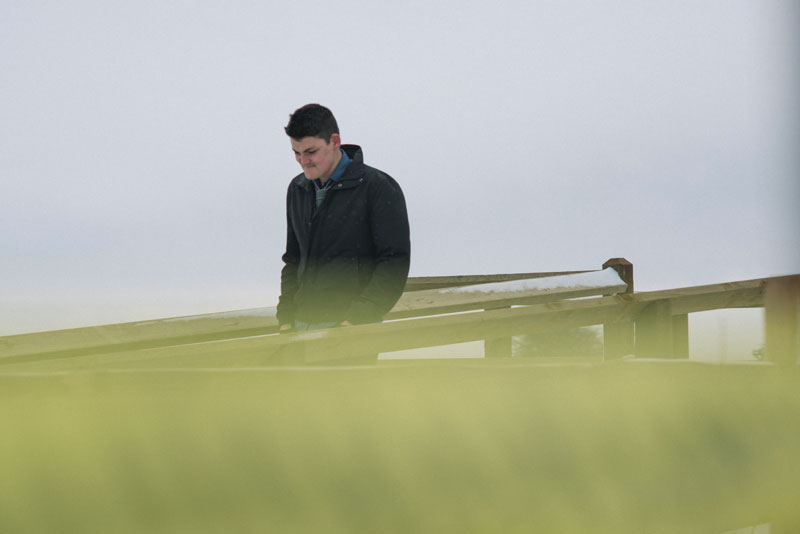
From an overseas Canuck like me, might as well be a message in a bottle. But if we all send one, especially Americans… we can float this issue with the DOT. Bring it to light.
Watch:
Be Heard:
National Highway Traffic Safety Administration (NFTSA)
U.S. Department of Transportation
1200 New Jersey Ave, SE
West Building
Washington, DC 20590
Get Educated:
ANSI STANDARD Z90.1 (1966-1979). American National Standards Institute, 1430 Broadway, New York, NY 10018.
Cadex Inc., “DOT Headform K1A”, Testing Laboratory Equipment, http://www.cadexinc.com/dot_headform.php, 2018.
Cadex Inc., “EN960 – Full Headform – Magnesium K1A”, Testing Laboratory Equipment, http://www.cadexinc.com/en960_full_magnesium_k1a_headform.php, 2018.
Cadex Inc., “Half Headform for American & Canadian Industrial Headwear (ISO)”, Testing Laboratory Equipment, http://www.cadexinc.com/iso_headform.php, 2018.
Covell, Claudia, “Counterfeit and Noncompliant Safety Equipment: Motorcycle Helmets”, Office of Vehicle Safety Compliance, NHTSA, https://one.nhtsa.gov/DOT/NHTSA/NRD/Multimedia/PDFs/Public Paper/SAE/2007/2007 SAE Gov Ind Mtg_Covell.pdf, May 2007.
Hurt, H.H. Jr., D.R. Thom & T.A. Smith, “Updating the Twenty-Year Old DOT Helmet Standard (FMVSS No. 218)”, 40th Proceedings of the Association for the Advancement of Automotive Medicine, Oct. 1996.
Liu, William Jia-Jiunn, “Analysis of Motorcycle Helmet Test Data for FMVSS No. 218,” Proceedings of the 1980 International Motorcycle Safety Conference, Motorcycle Safety Foundation, 1980.
NHTSA, “Standard No. 218; Motorcycle Helmets,” Code of Federal Regulations Title 49 Part 571.218, https://www.ecfr.gov/cgi-bin/text-idx?SID=0b03b2c80fce1aa8edf303bc44e71eeb&mc=true&node=se49.6.571_1218&rgn=div8, Jan. 2012.
Office of Vehicle Safety Compliance, “Compliance Database”, NHTSA, https://icsw.nhtsa.gov/cars/problems/comply/, 2017.
Snell Memorial Foundation, “Motorcycle Helmet Standard Comparisons”, http://www.smf.org/docs/articles/mcomp2.html, Nov. 2002.
Snell Memorial Foundation, “2015 Standard for Protective Headgear”, http://www.smf.org/standards/m/2015/M2015FinalFinal, 2015.
Thom, D.R. et al., “Modernization of the DOT Motorcycle Helmet Standard,” Head Protection Research Laboratory, https://www.msf-usa.org/downloads/imsc2001/Thom.pdf., 2001.
Thom, D.R., H.H. Hurt, Jr., T.A. Smith & J.V. Ouellet, “Feasibility Study of Upgrading FMVSS No. 218, Motorcycle Helmets,” Final Report to National Highway Traffic Safety Administration, U.S. Dept. of Transportation, Contract Order No. DTNH22-97-P-02001, September 1997.
United Nations Economic Commission for Europe, “Regulation No. 22 (Rev.1/Add.21/Rev.4)”, https://www.unece.org/fileadmin/DAM/trans/main/wp29/wp29regs/r022r4e.pdf, Sept. 2002.
Vander Vorst, M.J. and P.C. Chan, “Biofidelity of Motorcycle Helmet Criteria”, Proceedings of the Thirty-Third International Workshop on Injury Biomechanics Research, https://www-nrd.nhtsa.dot.gov/pdf/bio/proceedings/2005_33/33-2.pdf, 2005.
Congratulations @fortnine! You have completed some achievement on Steemit and have been rewarded with new badge(s) :
Click on any badge to view your own Board of Honor on SteemitBoard.
For more information about SteemitBoard, click here
If you no longer want to receive notifications, reply to this comment with the word
STOPThis is great work FortNine .... I'm surprised it only has 1 Vote and 1 Comment from 1,314 Vews (As of 26th March and before I found it).
Informative post guys! This deserves more.
Try being regular.
Congratulations @fortnine! You have received a personal award!
Click on the badge to view your Board of Honor.
Do not miss the last post from @steemitboard:
Congratulations @fortnine! You received a personal award!
You can view your badges on your Steem Board and compare to others on the Steem Ranking
Vote for @Steemitboard as a witness to get one more award and increased upvotes!